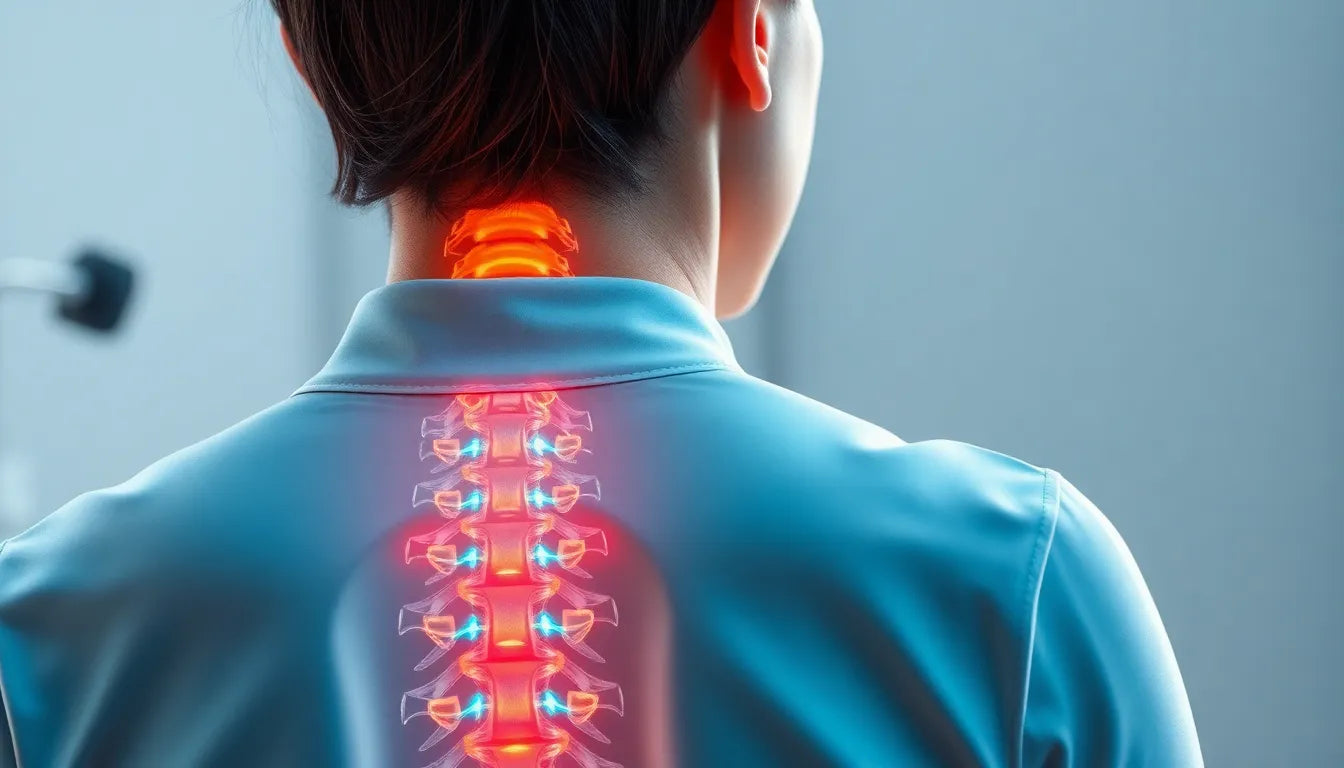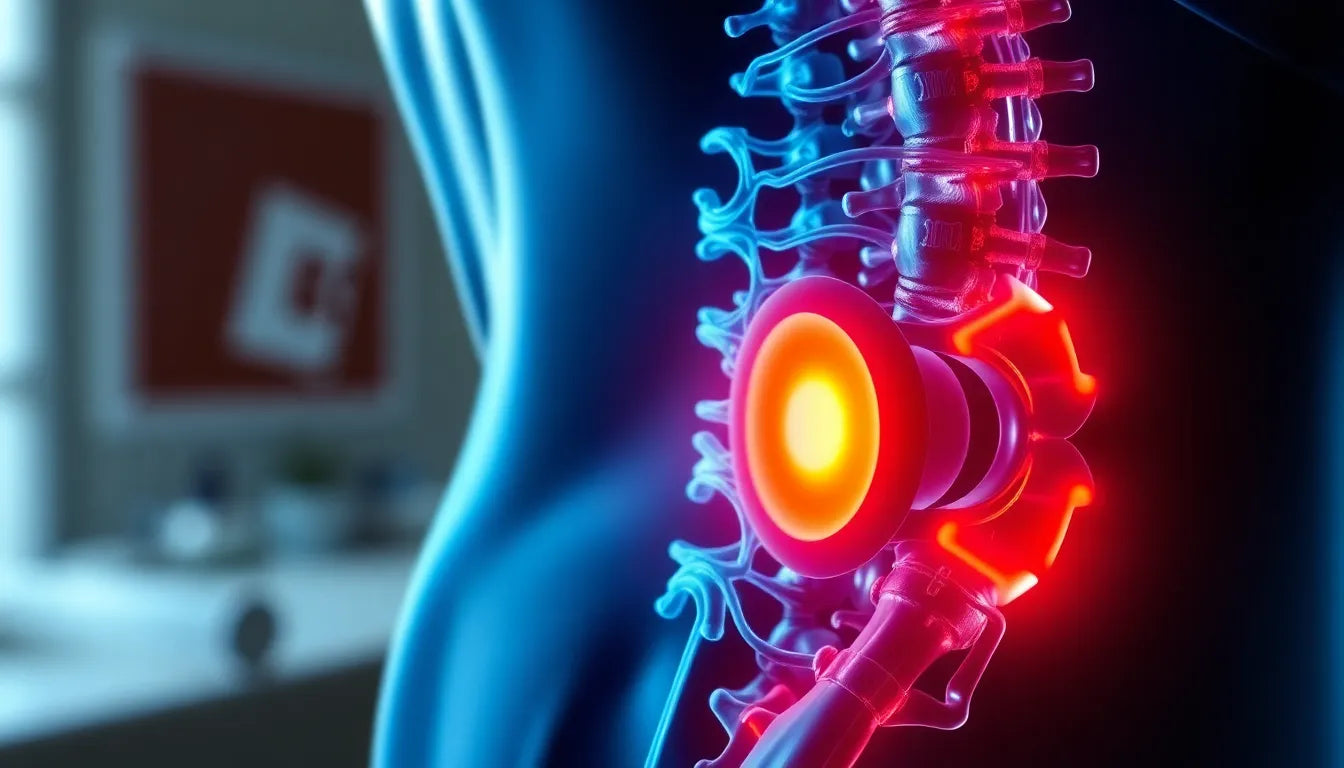Imagine experiencing sudden, sharp pain in your lower back or neck, making even simple movements challenging. This could be a sign of a herniated disc. Understanding what a herniated disc is and how it affects your body is crucial for managing the discomfort and preventing further issues.
what is a herniated disc?
A herniated disc occurs when the inner gel-like core of a spinal disc protrudes through a tear in its tougher outer layer. Think of your spinal disc as a jelly donut: when the jelly (nucleus) pushes out through a tear in the donut's outer layer (annulus), it can irritate nearby nerves, leading to pain, numbness, or weakness in the affected area.
prevalence and importance
Herniated discs are a common condition, particularly among adults. They often result from age-related degeneration, where the discs become less flexible and more prone to tearing. However, they can also occur due to injury or strain, such as heavy lifting or sudden pressure on the spine. The prevalence of herniated discs increases with age, making it a significant concern for many people seeking to maintain an active lifestyle.
The impact of a herniated disc on daily life can be substantial. It can limit your ability to perform everyday tasks, affect your work, and reduce your quality of life. Understanding this condition is essential for managing symptoms effectively and exploring treatment options that can help you get back to your normal activities.
In the following sections, we will delve deeper into the anatomy of the spine, the causes and risk factors associated with herniated discs, and the symptoms and diagnostic methods used to identify this condition. By gaining a comprehensive understanding, you'll be better equipped to address any concerns related to herniated discs and take proactive steps toward recovery.
anatomy and function of spinal discs
The human spine is a complex structure composed of vertebrae, which are the individual bones stacked on top of each other, forming the spinal column. Between each vertebra lies a spinal disc, a soft, rubbery pad that acts as a cushion. These discs function as shock absorbers, allowing flexibility and movement while protecting the vertebrae from impacts. Each disc consists of a tough outer layer known as the annulus fibrosus and a gel-like center called the nucleus pulposus. This unique structure enables discs to absorb stress during activities like lifting, twisting, and bending.
causes and risk factors of herniated discs
Age-related wear and tear, known as disc degeneration, is the primary cause of herniated discs. As we age, spinal discs lose water content, making them less flexible and more prone to rupture or herniation. However, several other factors can increase the risk of developing a herniated disc:
- Heavy lifting: Frequent lifting of heavy objects, especially using improper techniques, can strain the spine and lead to disc herniation.
- Sudden pressure: Sudden, intense pressure on the spine, such as from a fall or accident, can cause a disc to herniate.
- Obesity: Excess body weight places additional stress on the spine, increasing the likelihood of disc problems.
- Genetics: A family history of herniated discs can predispose individuals to similar issues.
Below is a summary table of risk factors and their potential impact on disc health:
| Risk Factor | Impact on Disc Health |
|---|---|
| Age | Increased degeneration and susceptibility to herniation |
| Heavy lifting | Increased strain and potential for disc rupture |
| Obesity | Additional stress leading to increased risk of herniation |
| Genetics | Predisposition to disc degeneration and herniation |
symptoms and diagnosis of herniated discs
The symptoms of a herniated disc can vary depending on the location of the herniation and the nerves affected. Common symptoms include:
- Localized pain: Sharp or burning pain in the neck or lower back.
- Numbness and tingling: Sensations of numbness or tingling in the areas served by the affected nerves.
- Weakness: Muscle weakness in the affected area, which may hinder mobility.
Symptoms often differ based on the herniation's location:
- Lumbar herniation: Pain radiating down the legs, often referred to as sciatica, due to pressure on the sciatic nerve.
- Cervical herniation: Pain and numbness in the shoulders, arms, or hands, as the herniated disc affects nerves in the neck region.
Accurate diagnosis of a herniated disc typically involves a combination of a physical examination and imaging tests. A healthcare provider may conduct a physical exam to assess reflexes, muscle strength, and sensation. Imaging tests such as MRI or CT scans provide detailed images of the spine, helping to confirm the presence and location of a herniated disc.
Understanding the anatomy, causes, and symptoms of herniated discs is crucial for identifying the condition early and seeking appropriate treatment. In the next section, we will explore various treatment options and recovery strategies for managing herniated discs effectively.
treatment and recovery options for herniated discs
When dealing with a herniated disc, understanding your treatment options is crucial for effective recovery. Most cases can be managed with conservative treatments, allowing you to return to normal activities within a few weeks. Here are some key treatment strategies:
- Rest and physical therapy: Resting the affected area and engaging in physical therapy can help alleviate pain and improve flexibility and strength.
- Pain medications: Over-the-counter pain relievers, such as ibuprofen or acetaminophen, can reduce inflammation and discomfort.
- Ergonomic aids: Products like those offered by Anodyne can support recovery by promoting proper posture and reducing strain on the spine.
In some cases, if conservative treatments don't provide relief, surgical intervention may be necessary. Surgical options include:
- Discectomy: Removal of the herniated portion of the disc to relieve pressure on the nerve.
- Laminectomy: Removal of part of the vertebra to widen the spinal canal and reduce nerve pressure.
It's important to consult with a healthcare professional to determine the best treatment plan based on the severity of your herniated disc and your individual health needs.
stages of herniation
Understanding the stages of disc herniation can help in recognizing the progression of this condition and its potential implications. The stages include:
- Degeneration: Initial weakening of the disc due to age-related wear and tear.
- Prolapse: The disc starts to bulge out but the inner core remains contained within the outer layer.
- Extrusion: The inner core breaks through the outer layer but remains connected to the disc.
- Sequestration: The inner core breaks free and becomes a fragment in the spinal canal.
Each stage can present different symptoms and challenges, underscoring the importance of early diagnosis and management.
conclusion
While a herniated disc can be a painful and disruptive condition, understanding its nature and the available treatment options is the first step towards effective management and recovery. By staying informed and consulting healthcare professionals, you can take proactive steps to alleviate symptoms and improve your quality of life.
frequently asked questions
What are the early signs of a herniated disc?
Initial signs include sudden back pain, tingling, or numbness in extremities, often worsening with movement.
Can a herniated disc heal on its own?
Yes, many cases resolve with conservative treatment over several weeks.
When should I see a doctor for a herniated disc?
Seek medical attention if you experience severe, persistent pain, or if symptoms worsen.
Are there ways to prevent herniated discs?
Maintain a healthy weight, practice good posture, and use ergonomic aids to reduce strain on the spine.
How can ergonomic aids help with herniated discs?
Ergonomic aids support proper spinal alignment, reduce pressure on discs, and can alleviate pain during recovery.
Sources
- Mayo Clinic Staff. "Herniated Disk: Symptoms and Causes." Mayo Clinic.
- Cleveland Clinic Staff. "Herniated Disc." Cleveland Clinic.
- Penn Medicine Staff. "Herniated Disc." Penn Medicine.
- American Association of Neurological Surgeons. "Herniated Disc." AANS.
- NewYork-Presbyterian Och Spine. "Herniated Disc." NewYork-Presbyterian.
- MedlinePlus. "Herniated Disk." MedlinePlus.



